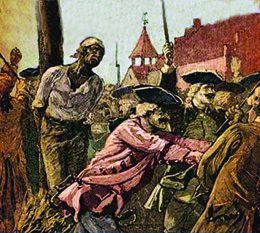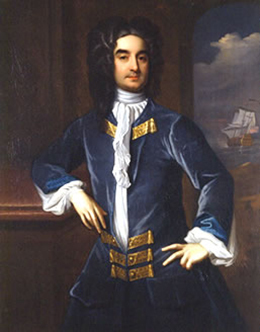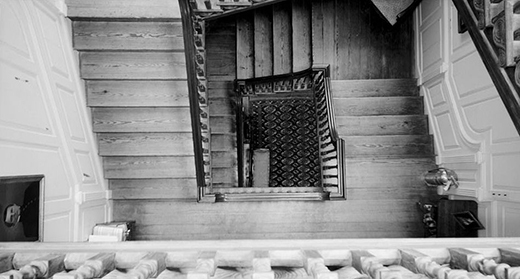| << Chapter < Page | Chapter >> Page > |

The events of 1741 in New York City illustrate the racial divide in British America, where panic among whites spurred great violence against and repression of the feared slave population. In the end, the Conspiracy Trials furthered white dominance and power over enslaved New Yorkers.
View the map of New York in the 1740s at the New York Public Library’s digital gallery, which allows you to zoom in and see specific events. Look closely at numbers 55 and 56 just north of the city limits to see illustrations depicting the executions.
British Americans’ reliance on indentured servitude and slavery to meet the demand for colonial labor helped give rise to a wealthy colonial class—the gentry—in the Chesapeake tobacco colonies and elsewhere. To be “genteel,” that is, a member of the gentry, meant to be refined, free of all rudeness. The British American gentry modeled themselves on the English aristocracy, who embodied the ideal of refinement and gentility. They built elaborate mansions to advertise their status and power. William Byrd II of Westover, Virginia, exemplifies the colonial gentry; a wealthy planter and slaveholder, he is known for founding Richmond and for his diaries documenting the life of a gentleman planter ( [link] ).

The diary of William Byrd, a Virginia planter, provides a unique way to better understand colonial life on a plantation ( [link] ). What does it show about daily life for a gentleman planter? What does it show about slavery?
August 27, 1709
I rose at 5 o’clock and read two chapters in Hebrew and some Greek in Josephus. I said my prayers and ate milk for breakfast. I danced my dance. I had like to have whipped my maid Anaka for her laziness but I forgave her. I read a little geometry. I denied my man G-r-l to go to a horse race because there was nothing but swearing and drinking there. I ate roast mutton for dinner. In the afternoon I played at piquet with my own wife and made her out of humor by cheating her. I read some Greek in Homer. Then I walked about the plantation. I lent John H-ch £7 [7 English pounds] in his distress. I said my prayers and had good health, good thoughts, and good humor, thanks be to God Almighty.
September 6, 1709
About one o’clock this morning my wife was happily delivered of a son, thanks be to God Almighty. I was awake in a blink and rose and my cousin Harrison met me on the stairs and told me it was a boy. We drank some French wine and went to bed again and rose at 7 o’clock. I read a chapter in Hebrew and then drank chocolate with the women for breakfast. I returned God humble thanks for so great a blessing and recommended my young son to His divine protection. . . .
September 15, 1710
I rose at 5 o’clock and read two chapters in Hebrew and some Greek in Thucydides. I said my prayers and ate milk and pears for breakfast. About 7 o’clock the negro boy [ or Betty] that ran away was brought home. My wife against my will caused little Jenny to be burned with a hot iron, for which I quarreled with her. . . .

One of the ways in which the gentry set themselves apart from others was through their purchase, consumption, and display of goods. An increased supply of consumer goods from England that became available in the eighteenth century led to a phenomenon called the consumer revolution. These products linked the colonies to Great Britain in real and tangible ways. Indeed, along with the colonial gentry, ordinary settlers in the colonies also participated in the frenzy of consumer spending on goods from Great Britain. Tea, for example, came to be regarded as the drink of the Empire, with or without fashionable tea sets.
The consumer revolution also made printed materials more widely available. Before 1680, for instance, no newspapers had been printed in colonial America. In the eighteenth century, however, a flood of journals, books, pamphlets, and other publications became available to readers on both sides of the Atlantic. This shared trove of printed matter linked members of the Empire by creating a community of shared tastes and ideas.
Cato’s Letters , by Englishmen John Trenchard and Thomas Gordon, was one popular series of 144 pamphlets. These Whig circulars were published between 1720 and 1723 and emphasized the glory of England, especially its commitment to liberty. However, the pamphlets cautioned readers to be ever vigilant and on the lookout for attacks upon that liberty. Indeed, Cato’s Letters suggested that there were constant efforts to undermine and destroy it.
Another very popular publication was the English gentlemen’s magazine the Spectator , published between 1711 and 1714. In each issue, “Mr. Spectator” observed and commented on the world around him. What made the Spectator so wildly popular was its style; the essays were meant to persuade, and to cultivate among readers a refined set of behaviors, rejecting deceit and intolerance and focusing instead on the polishing of genteel taste and manners.
Novels, a new type of literature, made their first appearance in the eighteenth century and proved very popular in the British Atlantic. Daniel Defoe’s Robinson Crusoe and Samuel Richardson’s Pamela: Or, Virtue Rewarded found large and receptive audiences. Reading also allowed female readers the opportunity to interpret what they read without depending on a male authority to tell them what to think. Few women beyond the colonial gentry, however, had access to novels.
The seventeenth and eighteenth centuries saw the expansion of slavery in the American colonies from South Carolina to Boston. The institution of slavery created a false sense of superiority in whites, while simultaneously fueling fears of slave revolt. White response to such revolts, or even the threat of them, led to gross overreactions and further constraints on slaves’ activities. The development of the Atlantic economy also allowed colonists access to more British goods than ever before. The buying habits of both commoners and the rising colonial gentry fueled the consumer revolution, creating even stronger ties with Great Britain by means of a shared community of taste and ideas.

Notification Switch
Would you like to follow the 'U.s. history' conversation and receive update notifications?